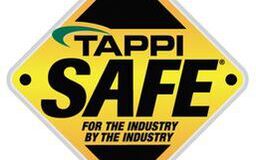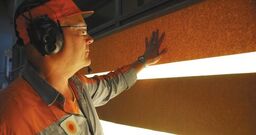Know the State of Your Emergency Showers
GRAEME RODDEN
At a recent Pulp and Paper Safety Association (PPSA) conference, Larry Kilian, director of corporate accounts with Haws, presented some interesting and important facts about emergency shower/eye wash stations. Some of the examples he provided would have been amusing if not for the fact that they were so alarming.
Kilian pointed out research findings showing that, on average, only 25 percent of emergency shower/eye wash stations work properly and can provide proper first aid—despite weekly or monthly checks. It should not be forgotten that the emergencies related to wash stations can have a serious and permanent effect on workers’ health and can even be life threatening.
 For example, Kilian explained that, in the case of acid burns, the rate of deep tissue burns occurring when proper first aid is administered is 12.5 percent versus 63 percent when it is not. With proper aid, the hospitalization rate is 7.5 days, compared with 20.5 days when proper aid is not available.
For example, Kilian explained that, in the case of acid burns, the rate of deep tissue burns occurring when proper first aid is administered is 12.5 percent versus 63 percent when it is not. With proper aid, the hospitalization rate is 7.5 days, compared with 20.5 days when proper aid is not available.
For alkali burns, the mortality rate is 9.5 percent when proper emergency response is available, but leaps to 20.1 percent when it is not. Nineteen percent of alkali burn victims require skin grafts when proper aid is available compared with 36 percent when it is not. As Kilian said, “Ensuring the state of readiness of emergency equipment can make a major difference in outcomes.”
What are some reasons for non-compliance with ISEA/ANSI Z358.1 requirements?
•No dust covers: Outlets should be protected from airborne contaminants to help eliminate additional injury.
• Lack of visible signage: Emergency equipment location should be well-lit and identified with a highly visible sign.
• Incorrect application: The appropriate level of safety response should be provided based on the potential hazard. Often, eyewash units are used for chemical hazards when the recommended solution should be an eye/face wash.
• Obstructed access: A safety station must be located on the same level as the hazard and the path of travel must be free of obstructions.
• Incorrect installation: For example, showerheads, under ANSI requirements, must be 82-96 inches above the surface floor of the user. Kilian showed examples that were well under the required height, making it difficult for taller people to get under the showerhead. The actuator cannot be more than 69 inches from the surface floor of the user.
• Inoperable components: The valve must be simple to operate and go from “off” to “on” in one second or less. It is not uncommon to find faulty valves that cannot be activated. Plus, the valve must stay on for the full 15-minute flush without the use of hands.
• Too much or too little flow: Eye and eye/face washes must provide a means of controlled flow to both eyes simultaneously at a velocity low enough to be non-injurious. Kilian showed examples of the opposite with water  shooting out of the nozzle. Ophthalmologists say comfortable water pressure and tempered water are the most important features to consider.
shooting out of the nozzle. Ophthalmologists say comfortable water pressure and tempered water are the most important features to consider.
• Incorrect flow pattern: The eyewash must allow for the required flushing of both eyes simultaneously.
• The wrong shower flow rate and pattern: A shower must deliver a minimum of 20 gal/min (75 L) and provide a column of water 20 in. (50.8 cm) wide at 60 in. (152.4 cm) above the surface floor of the user.
• Water temperature: It should be between 60-100°F (15.6-37.8°C).
• Won’t support simultaneous use: Combination shower and eyewash unit components must be able to operate simultaneously and maintain their flow rates. A lack of flow to the eyewash once the shower is activated is one of the most common reasons units are not functioning correctly, putting the user at risk.
KNOWLEDGE AND ACCOUNTABILITY
There are a couple of root causes that explain why non-compliance is so common. The first is a lack of knowledge: i.e., knowing what to look for and knowing how to conduct a weekly or annual inspection. The second is an accountability issue: a mill needs to have clear ownership and a process for reporting and resolving issues.
Kilian provided four key steps to mitigate risks and improve the reliability of emergency equipment.
• Know your showers’ current state of readiness; consider a shower survey/inspection by a third party subject matter expert (SME).
• Assign accountability for weekly inspections and providing annual training to those doing the inspections.
• Provide the proper tools needed to conduct weekly and annual tests appropriately.
• Explore new technologies that improve the reliability of emergency showers and eyewashes, and solve the three most common flow issues users struggle with.
Kilian’s presentation was part of the program at the PPSA 2016 Annual Health and Safety Conference. The 2017 conference is set for June 18-21, 2017, at the Charleston Marriott in Charleston, SC. The program will cover a range of safety topics, case studies, regulatory updates, and more. To learn more about the conference, or for other safety resources, visit ppsa.org.
Graeme Rodden is Paper360° senior editor, North and South America. Reach him at grodden@tappi.org
Upgrade Resolves Large-scale Non-compliance
When a new site safety manager joined one of North America’s leading manufacturers of corrugated and consumer packaging, he suspected there were issues with the plant’s emergency response equipment, particularly safety showers and eyewashes. After attending a presentation at a North American safety meeting, he invited Haws to conduct an onsite ANSI emergency shower and eyewash survey, which revealed that only 3 percent of the facility’s 60+ units were compliant with ISEA/ANSI Z358.1 Standard. A full 81 percent were categorized as non-compliant due to multiple violations including significant performance issues and/or improper installation.
Following a thorough review of Haws safety shower and eyewash survey results, the safety manager purchased 40 AXION Advantage kits to retrofit the majority of the plant’s existing showers and eyewashes, which included product from a variety of companies. The AXION technology solved the common problems associated with owning and maintaining emergency equipment, including an overabundance of flow, lack of simultaneous flow to the eyewash heads when the shower is activated, and uneven flow pattern. He also liked that AXION aligned with standard medical protocols for effective eye flushing.
The Advantage kits solved the flow issues at the plant and brought 95 percent of its units into compliance, with the remainder waiting on piping adjustments. The single-head design for greater flow reliability was key and the plant has adopted a standard specification based on the AXION technology. The staff described the Haws shower and eyewash survey as “completely effective” and “extremely useful” in helping them understand the state of the facility’s emergency equipment and improving its level of compliance with ISEA/ANSI Z358.1 requirements.
Under ANSI requirements, showerheads must be 82-96 inches above the surface floor of the user, while the actuator cannot be more than 69 inches from the surface floor of the user.
The eyewash must allow for the required flushing of both eyes simultaneously.




